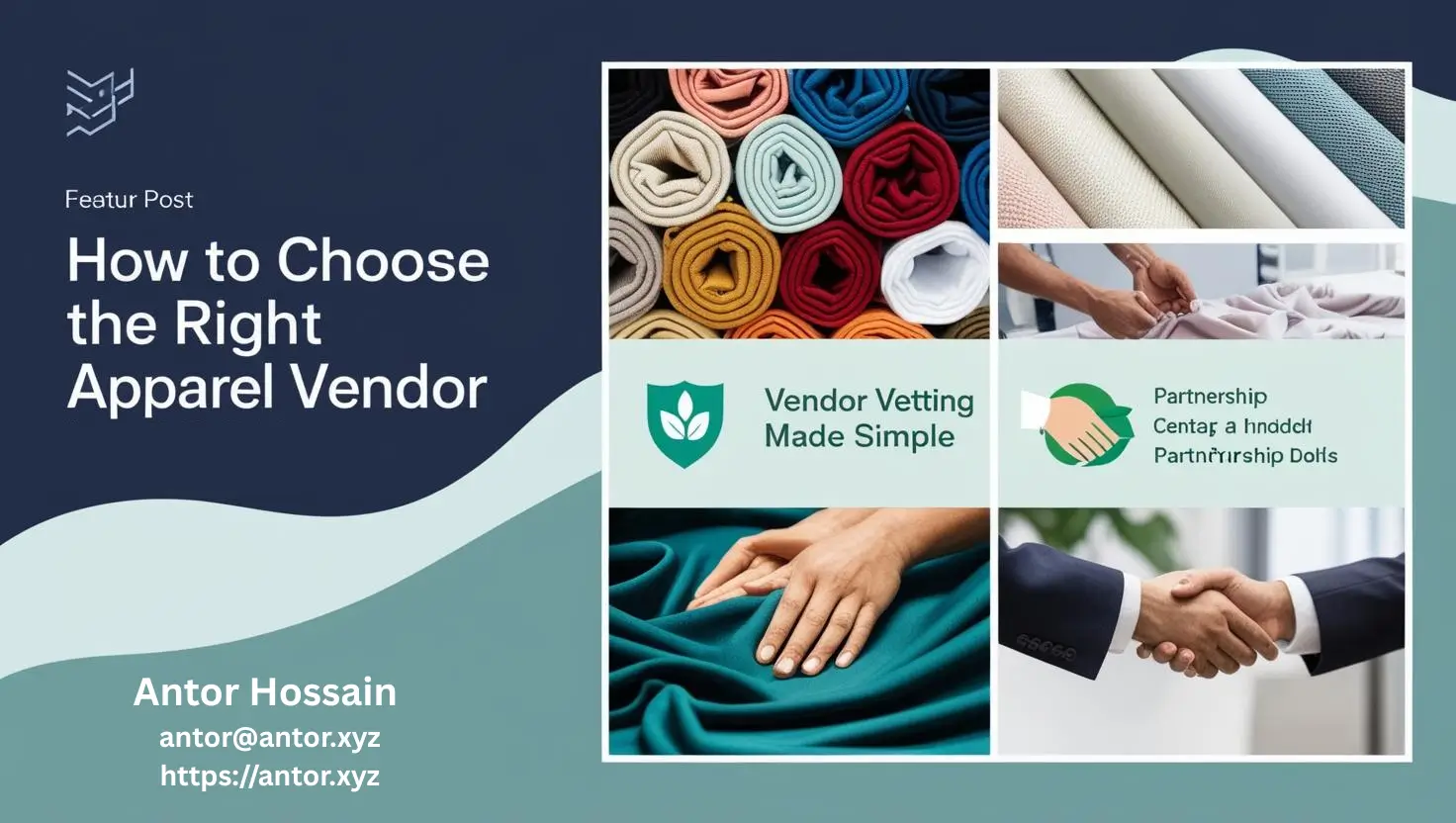
Summary
Selecting the right apparel vendor requires a structured, criteria‑driven approach—from defining precise product requirements and budget constraints to rigorous vetting, negotiation, and building long‑term partnerships. Buyers must evaluate quality management systems, sustainability credentials, production capacity, lead‑time reliability, and ethical practices, while also accounting for emerging trends such as nearshoring, digital product passports, blockchain traceability, and 3D sampling. Following these steps ensures resilient sourcing, cost efficiency, and strong brand differentiation.
1. Define Your Requirements and Priorities
1.1 Clarify Product Specifications
Document all design details—fabrics, trims, tolerances, finishes, and performance tests—to quickly eliminate vendors unable to meet your standards.
1.2 Establish Budget and MOQs
Set clear unit‑cost targets, total budget limits, and minimum order quantities (MOQs) up front. This filters out vendors outside your financial scope.
2. Key Vendor Selection Criteria
2.1 Quality Management and Certifications
Verify the vendor’s ISO 9001 quality management system and compliance track record. Confirm textile‑safety certifications such as OEKO‑TEX® STANDARD 100 to ensure products are free from harmful substances.
2.2 Sustainability and ESG Credentials
Use the Higg Index to benchmark environmental and social impacts. Seek suppliers tracking water use, waste, and labor conditions in line with EU Digital Product Passport regulations.
2.3 Traceability and Transparency
Adopt blockchain‑enabled platforms to trace materials end‑to‑end, prevent counterfeits, and demonstrate provenance.
2.4 Digital Sampling Capabilities
Partner with vendors offering 3D digital sampling to slash prototype time and material waste, accelerating design decisions.
2.5 Production Capacity and Scalability
Assess annual throughput, peak‑season flexibility, and contingency plans. Consider “friend‑shoring” hubs such as Vietnam or Cambodia for diversified capacity..
2.6 Lead Times and Logistics
Confirm typical lead times (4–12 weeks) and review carriers, in‑house freight options, and recent disruptions; delays have grown from ~6 weeks to 8+ weeks in peak seasons.
2.7 Ethical Labor Practices
Ensure vendors hold Fair Labor Association accreditation or equivalent, demonstrating adherence to high labor‑rights standards.
3. 2025‑Specific Considerations
3.1 Nearshoring and Geopolitics
Shift portions of your order book to lower‑cost “friend‑shoring” locations to mitigate tariff risks and political volatility.
3.2 Digital Product Passports (DPP)
Begin integrating DPP data collection now; by 2030 all EU‑sold products must carry a QR‑linked passport detailing material origin, manufacturing footprint, and end‑of‑life options.
3.3 Supply‑Chain Resilience
Diversify vendor base across regions, bolster inventory buffers, and implement real‑time order‑tracking dashboards to respond swiftly to disruptions.
4. Vetting and Due Diligence
4.1 Factory Audits
Conduct on‑site or third‑party audits of health, safety, equipment, and capacity claims. Use checklists aligned with ISO and FLA standards.
4.2 Sample Reviews and Inspections
Order color‑fastness, wash‑test, and fit samples. Employ independent inspectors for random bulk‑run checks to safeguard quality.
5. Negotiation and Contracting
5.1 Terms, Pricing & SLAs
Leverage detailed multi‑vendor cost breakdowns to negotiate volume discounts, payment terms, and late‑delivery penalties. Document SLAs for lead times, quality thresholds, and escalation protocols.
5.2 Continuous Improvement Clauses
Include clauses for joint innovation—purchasing commitments in exchange for co‑funded R&D on sustainable materials or process optimizations.
6. Building Strategic Partnerships
Rather than transactional orders, aim for strategic alliances: share market insights, collaborate on ESG initiatives, pilot new technologies (e.g., AI‑driven demand forecasting), and jointly develop circular‑economy programs. Long‑term partnerships yield cost efficiencies, faster time‑to‑market, and brand differentiation.
Ready to elevate your apparel sourcing in 2025?
Contact Antor Hossain at antor@antor.xyz or visit antor.xyz to discover how Ethnotex Private Limited can streamline your end‑to‑end apparel development, production, and logistics.
References
- Tetra Inspection. (2022). Apparel Quality Control Standards and Regulations. Retrieved from https://tetrainspection.com/apparel-quality-control/
- OEKO‑TEX®. (n.d.). OEKO‑TEX® STANDARD 100. Retrieved from https://www.oeko-tex.com/en/our-standards/oeko-tex-standard-100
- Sustainable Apparel Coalition. (n.d.). Higg Index Tools. Retrieved from https://product.higg.org/page/sustainable-apparel-coalition
- European Parliamentary Research Service. (2024). Digital product passport for the textile sector. Retrieved from https://www.europarl.europa.eu/RegData/etudes/STUD/2024/757808/EPRS_STU%282024%29757808_EN.pdf
- TexSpaceToday. (2025). How blockchain ensures traceability in fashion supply chain. Retrieved from https://www.texspacetoday.com/how-blockchain-ensures-traceability-in-fashion-supply-chain/
- ThePro3DStudio. (2023). Benefits of 3D Digital Sampling for Fashion Brands. Retrieved from https://professional3dservices.com/blog/3d-sampling-in-fashion-industry.html
- Investopedia. (2025). Manufacturing Already Moved Out of China. Now Where Will It Go? Retrieved from https://www.investopedia.com/manufacturing-already-moved-out-of-china-now-where-will-it-go-11711407
- SupplyChainDive. (2018). Which apparel players have the fastest lead times? Retrieved from https://www.supplychaindive.com/news/Apparel-lead-times-McKinsey-vertical-integration/540806/
- Fair Labor Association. (n.d.). Standards that advance workers’ rights. Retrieved from https://www.fairlabor.org/
- S&P Global Market Intelligence. (2024). Logistics disruptions’ impact on apparel supply chains. Retrieved from https://www.spglobal.com/market-intelligence/en/news-insights/research/logistics-disruptions-impact-on-apparel-supply-chains
- Vogue Business. (2024). The fashion exec’s guide to digital product passports. Retrieved from https://www.voguebusiness.com/story/sustainability/the-fashion-execs-guide-to-digital-product-passports
Share Button